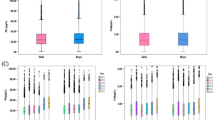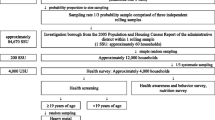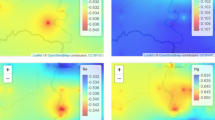Abstract
This study was to investigate blood lead (Pb) and cadmium (Cd) levels and time trend in rural Chinese children derived from the China Nutrition and Health Survey 2002 and 2012 (CNHS 2002, CNHS 2012). In total, 1698 and 1581 of rural Chinese children were selected from the CNHS 2002 and the CNHS 2012 databases, respectively. The blood Pb and Cd levels were determined by inductively coupled plasma mass spectrometer (ICP-MS), whilst the prevalence of blood Pb levels >5 µg/dL and blood Cd levels >0.5 µg/L and the corresponding reference values (RV95s: the upper limit of 95% confidence interval of 95th percentile) were together calculated. From the CNHS 2002 to the CNHS 2012, median concentrations in blood were severally decreased from 6.3 to 3.1 µg/dL for Pb and from 0.64 to 0.39 µg/L for Cd. The prevalence of blood Pb levels >5 µg/dL had decreased from 63.6 to 14.2%, together with blood Cd levels >0.5 µg/L prevalence from 62.7 to 33.5%, respectively. The RV95s of blood Pb and Cd levels were 15.2 µg/dL and 1.54 µg/L in the CNHS 2002, as well as 6.3 µg/dL and 1.12 µg/L in the CNHS 2012. In conclusion, blood Pb and Cd levels had been obviously improved in rural Chinese children during the past 10 years. However, the risks of Pb and Cd exposure are still serious and required to have continuous health monitoring and evaluation, even call for greater collaboration of the government and society.


Similar content being viewed by others
Data Availability
The data used to support the findings of this study are available from the corresponding author upon reasonable request.
References
Jarup L (2003) Hazards of heavy metal contamination. Br Med Bull 68:167–182
Tchounwou PB, Yedjou CG, Patlolla AK, Sutton DJ (2012) Heavy metal toxicity and the environment. Exp Suppl 101:133–164
Rehman K, Fatima F, Waheed I, Akash MSH (2018) Prevalence of exposure of heavy metals and their impact on health consequences. J Cell Biochem 119(1):157–184
Satarug S, Gobe GC, Vesey DA, Phelps KR (2020) Cadmium and lead exposure, nephrotoxicity, and mortality. Toxics 8(4):86
Zeng X, Xu X, Boezen HM, Huo X (2016) Children with health impairments by heavy metals in an e-waste recycling area. Chemosphere 148:408–415
Laborde A, Tomasina F, Bianchi F, Brune MN, Buka I, Comba P, Corra L, Cori L, Duffert CM, Harari R, Iavarone I, McDiarmid MA, Gray KA, Sly PD, Soares A, Suk WA, Landrigan PJ (2015) Children’s health in Latin America: the influence of environmental exposures. Environ Health Perspect 123(3):201–209
Al Osman M, Yang F, Massey IY (2019) Exposure routes and health effects of heavy metals on children. Biometals 32(4):563–573
Kolossa-Gehring M, Fiddicke U, Leng G, Angerer J, Wolz B (2017) New human biomonitoring methods for chemicals of concern-the German approach to enhance relevance. Int J Hyg Environ Health 220(2 Pt A):103–112
Schulz C, Angerer J, Ewers U, Kolossa-Gehring M (2007) The German Human Biomonitoring Commission. Int J Hyg Environ Health 210(3–4):373–382
Ewers U, Krause C, Schulz C, Wilhelm M (1999) Reference values and human biological monitoring values for environmental toxins Report on the work and recommendations of the Commission on Human Biological Monitoring of the German Federal Environmental Agency. Int Arch Occup Environ Health 72(4):255–260
Calafat AM (2012) The U.S. National Health and Nutrition Examination Survey and human exposure to environmental chemicals. Int J Hyg Environ Health 215(2):99–101
Saravanabhavan G, Werry K, Walker M, Haines D, Malowany M, Khoury C (2017) Human biomonitoring reference values for metals and trace elements in blood and urine derived from the Canadian Health Measures Survey 2007–2013. Int J Hyg Environ Health 220(2 Pt A):189–200
Schulz C, Angerer J, Ewers U, Heudorf U, Wilhelm M, Human Biomonitoring Commission of the German Federal Environment A (2009) Revised and new reference values for environmental pollutants in urine or blood of children in Germany derived from the German Environmental Survey on Children 2003–2006 (GerES IV). Int J Hyg Environ Health 212(6):637–647
Hoet P, Jacquerye C, Deumer G, Lison D, Haufroid V (2021) Reference values of trace elements in blood and/or plasma in adults living in Belgium. Clin Chem Lab Med 59(4):729–742
Lee JW, Lee CK, Moon CS, Choi IJ, Lee KJ, Yi SM, Jang BK, Yoon BJ, Kim DS, Peak D, Sul D, Oh E, Im H, Kang HS, Kim J, Lee JT, Kim K, Park KL, Ahn R, Park SH, Kim SC, Park CH, Lee JH (2012) Korea National Survey for Environmental Pollutants in the Human Body 2008: heavy metals in the blood or urine of the Korean population. Int J Hyg Environ Health 215(4):449–457
He Y, Zhao W, Zhang J, Zhao L, Yang Z, Huo J, Yang L, Wang J, He L, Sun J, Piao J, Yang X, Ge K, Ding G (2019) Data resource profile: China National Nutrition Surveys. Int J Epidemiol 48(2):368–368f
Schulz C, Wilhelm M, Heudorf U, Kolossa-Gehring M, Human Biomonitoring Commission of the German Federal Environment A (2011) Update of the reference and HBM values derived by the German Human Biomonitoring Commission. Int J Hyg Environ Health 215(1):26–35
Taylor CM, Humphriss R, Hall A, Golding J, Emond AM (2015) Balance ability in 7- and 10-year-old children: associations with prenatal lead and cadmium exposure and with blood lead levels in childhood in a prospective birth cohort study. BMJ Open 5(12):e009635
Liao LM, Friesen MC, Xiang YB, Cai H, Koh DH, Ji BT, Yang G, Li HL, Locke SJ, Rothman N, Zheng W, Gao YT, Shu XO, Purdue MP (2016) Occupational lead exposure and associations with selected cancers: the Shanghai Men’s and Women’s Health Study cohorts. Environ Health Perspect 124(1):97–103
Almerud P, Zamaratskaia G, Lindroos AK, Bjermo H, Andersson EM, Lundh T, Ankarberg EH, Lignell S (2021) Cadmium, total mercury, and lead in blood and associations with diet, sociodemographic factors, and smoking in Swedish adolescents. Environ Res 197:110991
Cwielag-Drabek M, Piekut A, Gut K, Grabowski M (2020) Risk of cadmium, lead and zinc exposure from consumption of vegetables produced in areas with mining and smelting past. Sci Rep 10(1):3363
Kelsall LM, de Gooyer TE, Carey M, Vaughan L, Ansari Z (2013) Blood lead levels in the adult Victorian population: results from the Victorian Health Monitor. Aust N Z J Public Health 37(3):233–237
Forte G, Madeddu R, Tolu P, Asara Y, Marchal JA, Bocca B (2011) Reference intervals for blood Cd and Pb in the general population of Sardinia (Italy). Int J Hyg Environ Health 214(2):102–109
Nunes JA, Batista BL, Rodrigues JL, Caldas NM, Neto JA, Barbosa F Jr (2010) A simple method based on ICP-MS for estimation of background levels of arsenic, cadmium, copper, manganese, nickel, lead, and selenium in blood of the Brazilian population. J Toxicol Environ Health A 73(13–14):878–887
Wang S, Jin Y, Chen J, Lu L, Li Y, Zhao Q, Bu S, Geng X, Guan G, Qu W, Zheng Y, Tang J (2021) Blood lead levels of Chinese children from 1991 to 2020: based on Monte Carlo simulation. Environ Pollut 278:116823
Ahn B, Kim SH, Park MJ (2017) Blood cadmium concentrations in Korean adolescents: from the Korea National Health and Nutrition Examination Survey 2010–2013. Int J Hyg Environ Health 220(1):37–42
Olympio KPK, Silva J, Silva ASD, Souza VCO, Buzalaf MAR, Barbosa F Jr, Cardoso MRA (2018) Blood lead and cadmium levels in preschool children and associated risk factors in Sao Paulo, Brazil. Environ Pollut 240:831–838
Burm E, Song I, Ha M, Kim YM, Lee KJ, Kim HC, Lim S, Kim SY, Lee CG, Kim SY, Cheong HK, Sakong J, Kang HT, Son M, Oh GJ, Kim Y, Yang JY, Hong SJ, Seo JH, Kim J, Oh S, Yu J, Chang SS, Kwon HJ, Choi YH, Choi W, Kim S, Yu SD (2016) Representative levels of blood lead, mercury, and urinary cadmium in youth: Korean Environmental Health Survey in Children and Adolescents (KorEHS-C), 2012–2014. Int J Hyg Environ Health 219(4–5):412–418
Alvarez J, Del Rio M, Mayorga T, Dominguez S, Flores-Montoya MG, Sobin C (2018) A comparison of child blood lead levels in urban and rural children ages 5–12 years living in the border region of El Paso. Texas. Arch Environ Contam Toxicol 75(4):503–511
Popovic M, McNeill FE, Chettle DR, Webber CE, Lee CV, Kaye WE (2005) Impact of occupational exposure on lead levels in women. Environ Health Perspect 113(4):478–484
Jarup L, Berglund M, Elinder CG, Nordberg G, Vahter M (1998) Health effects of cadmium exposure–a review of the literature and a risk estimate. Scand J Work Environ Health 24(Suppl 1):1–51
Acknowledgements
We are very grateful to all the team members and participants involved in the China Nutrition and Health Survey 2002 and 2012.
Funding
This study was sponsored by the Danone Nutrition Fund (Grant No. DIC 2017-06) and the Young Scholar Scientific Research Foundation of Chinese Center for Disease Control and Prevention (Grant No. 2018A204).
Author information
Authors and Affiliations
Contributions
Xiaobing Liu and Xiaoguang Yang conceived and designed the conduction of this study; Xiaobing Liu, Huidi Zhang, Yu Zhang, Jun Wang, Hongxing Tan, and Lichen Yang performed the experiment; Xiaobing Liu wrote the manuscript; Xiaoguang Yang and Jianhua Piao reviewed the manuscript.
Corresponding authors
Ethics declarations
Competing interests
The authors declare no competing interests.
Conflict of Interest
The authors declare no competing interests.
Additional information
Publisher's Note
Springer Nature remains neutral with regard to jurisdictional claims in published maps and institutional affiliations.
Rights and permissions
About this article
Cite this article
Liu, X., Zhang, H., Zhang, Y. et al. The Time Trend of Blood Lead and Cadmium Levels in Rural Chinese Children: China Nutrition and Health Survey 2002 and 2012. Biol Trace Elem Res 201, 2162–2169 (2023). https://doi.org/10.1007/s12011-022-03333-0
Received:
Accepted:
Published:
Issue Date:
DOI: https://doi.org/10.1007/s12011-022-03333-0




